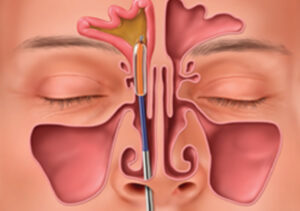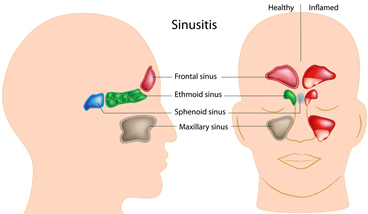In Office Balloon Sinuplasty Glendale & Burbank
Balloon Sinuplasty is a minimally invasive sinus procedure now available to eligible patients performed by Dr. Bublik at his Glendale, CA office under local anesthesia. Dr. Bublik also is happy to provide in office Balloon Sinuplasty to patients throughout the Los Angeles area including Pasadena.
This remarkable sinusitis treatment has achieved consistently outstanding results for countless patients, while requiring little or no anesthesia and minimal recovery time. This treatment is performed in place of more invasive and aggressive surgeries that involve general anesthesia with lengthy recovery processes. Balloon sinuplasty provides relief to those suffering from chronic sinusitis by opening blocked sinus passages and restoring normal drainage without incisions and tissue removal.
If you suffer from chronic sinusitis, you know that this condition can seriously impact your quality of life, causing a range of symptoms from sinus headaches to fatigue and halitosis (bad breath). It’s a condition that should be addressed and this new and surprisingly simple treatment is, for many people, the best way to address it. Most health insurance companies will cover all or part of balloon sinuplasty cost under most circumstances. This innovative procedure can be performed by Dr. Bublik right here in our Los Angeles office in as little as 20 minutes!
Balloon Sinuplasty Video Testimonial
What is Balloon Sinuplasty?
When performing balloon sinuplasty, Dr. Bublik will insert a catheter through the opening of the nose into the sinus opening and then thread a sinus guide wire into the targeted sinus, providing light transmission and illumination that will help Dr. Bublik ensure correct placement of the guide catheter. Once access to the intended location is confirmed, tiny balloons are placed in key places in the nose and sinuses, which are then dilated to expand and widen the sinus passageways. The goal is to reshape anatomy to restore proper drainage. Simple. No tissue removal. No bleeding. No pain.
Treating Chronic Sinusitis With Balloon Sinuplasty
Chronic sinusitis is a condition that occurs when the sinuses, the air-filled spaces in the skull, become inflamed for an extended period, typically more than 12 weeks. This type of inflammation prevents the mucus from draining normally from the sinus airways and nostrils.
The following symptoms are common with this condition:
- Nasal congestion or obstruction
- Facial pain and pressure
- Headaches
- Thick nasal discharge
- Reduced sense of smell and taste
- Fatigue
- Bad breath (halitosis)
Sinusitis can be triggered by various factors, including allergies, infections, nasal polyps, and structural abnormalities like a deviated septum. When sinusitis becomes chronic, it can significantly impact a person’s quality of life, leading to recurrent infections, constant discomfort, and the need for repeated antibiotic treatments.
Traditional Sinus Surgery vs. Balloon Sinuplasty
Before the introduction of balloon sinuplasty, patients suffering from chronic sinusitis often had to undergo traditional sinus surgery, known as Functional Endoscopic Sinus Surgery (FESS). FESS involves the removal of bone or tissue to enlarge the sinus openings and improve drainage. While effective, traditional surgery is more invasive, carries a higher risk of complications, and requires a longer recovery period.
Balloon sinuplasty on the other hand, is a minimally invasive alternative that uses a small, flexible balloon catheter to dilate the blocked sinus passages without removing any tissue. This technique reduces the risks associated with surgery and allows for a faster recovery.
How Balloon Sinuplasty Works


Balloon sinuplasty works by gently inflating a small balloon inside the blocked sinus passage, which widens the opening and restores normal drainage. Here’s how the procedure typically works:
- Preparation: The patient is either put under general anesthesia or given a local anesthetic, depending on the severity of the case and patient preference. The procedure is typically performed in an outpatient setting, allowing the patient to go home the same day.
- Insertion of the Balloon Catheter: The surgeon uses an endoscope, a small, flexible tube with a camera on the end, to guide the balloon catheter into the blocked sinus passage. The camera provides a clear view of the sinuses, allowing for precise placement of the balloon.
- Balloon Inflation: Once the balloon catheter is in place, the balloon is carefully inflated. As it expands, the balloon gently presses against the walls of the sinus passage, widening the opening and allowing for improved drainage.
- Restoration of Drainage: After the balloon is inflated and the sinus opening has been widened, the balloon is deflated and removed. The widened sinus passage allows for better airflow and drainage, which helps reduce inflammation and prevent future infections.
- Completion: The entire procedure usually takes around an hour, and most patients experience little to no pain during the surgery. There is no cutting or removal of tissue, which greatly reduces post-operative discomfort and speeds up recovery.
Balloon Sinuplasty Video
Who is a Candidate for Balloon Sinuplasty?
Balloon sinuplasty is not suitable for everyone with sinusitis. It is primarily for individuals who suffer from chronic sinusitis that has not responded to other treatments, such as medication, nasal sprays, or antibiotics. The ideal candidate for balloon sinuplasty typically meets the following criteria:
- Chronic sinusitis: Patients with sinusitis lasting more than 12 weeks and experiencing persistent symptoms like congestion, facial pain, or headaches.
- No severe structural abnormalities: Balloon sinuplasty is not recommended for patients with severe nasal polyps, tumors, or other significant structural issues in the nose or sinuses.
- Failed medical treatments: Individuals who have tried medication and other non-invasive treatments for sinusitis without success.
- Mild to moderate sinus blockages: Balloon sinuplasty is best suited for patients with mild to moderate sinus blockages. For more severe cases, traditional sinus surgery may still be necessary.
Also Read: 8 Reasons Why You Should Consider Balloon Sinuplasty If You Suffer From Recurring Sinus Problems
Balloon Sinuplasty Benefits
Balloon sinuplasty offers several benefits compared to traditional sinus surgery, making it an attractive option for patients looking for relief from chronic sinusitis. Some of the key benefits include:
1. Minimally Invasive
Balloon sinuplasty does not involve cutting or removing bone or tissue, which makes it less invasive than traditional sinus surgery. This results in less post-operative pain, reduced bleeding, and a faster recovery time.
2. Quicker Recovery
Because the procedure is less invasive, most patients can return to their normal activities within 24 to 48 hours. This is a significant improvement over traditional sinus surgery, which can require a recovery period of up to two weeks.
3. Outpatient Procedure
Balloon sinuplasty is typically performed in an outpatient setting, meaning patients can go home the same day as the procedure. This is more convenient and cost-effective than staying in a hospital for surgery.
4. Reduced Risk of Complications
Traditional sinus surgery carries a higher risk of complications, such as infection, scarring, and damage to surrounding tissues. Balloon sinuplasty, on the other hand, has a lower risk of complications because it is less invasive and does not involve cutting.
5. Effective Symptom Relief
Studies have shown that balloon sinuplasty is effective at providing long-term relief for patients suffering from chronic sinusitis. Many patients experience significant improvements in their symptoms, such as reduced congestion, fewer headaches, and better breathing.
6. Less Need for Medications
After balloon sinuplasty, many patients find that they no longer need to rely on medications like nasal sprays, decongestants, or antibiotics to manage their symptoms. This can lead to improved overall health and fewer side effects from long-term medication use.
In Office Balloon Sinuplasty Case – Video
Balloon Sinuplasty: Difference Between This and Other Treatments
The benefits of In–Office Balloon Sinuplasty performed by Dr. Bublik represent a marked improvement over traditional sinus surgery, which are performed with general anesthesia and involve a longer recovery with more postoperative care requirements.
As groundbreaking as the balloon sinuplasty procedure is, the quality of the physician performing it is also crucial. Dr. Bublik was one of the first surgeons in the country to work with Balloon technology when it was in its developmental phases.
Dr. Bublik also trained with leading experts and international renowned sinus surgeons and has implemented their techniques in his own practice. With many years of experience studying and working with sinus-related concerns, including sinusitis, nasal congestion, and allergies, Dr. Bublik is the type of ear, nose, and throat (ENT) doctor in Glendale and Los Angeles surrounding areas patients trust and seek out.
He is a widely respected surgeon and medical specialist with a tremendous amount of experience, making him the sinus surgeon that patients seek out not only for primary sinus surgery and in-office balloon sinuplasty, but also for more complicated REVISION SINUS SURGERY.
While the in-office balloon sinuplasty procedure can be an exceptionally effective way to clear sinuses for many patients, Dr. Bublik points out that it is not necessarily the right choice for everyone and therefore a comprehensive consultation with Dr. Bublik is performed prior to any procedure. In general, however, patients diagnosed with chronic sinusitis who are not responding well to medications may be candidates for sinus surgery with the balloon technology.
For questions regarding balloon sinuplasty, in-office balloon sinuplasty, sinus surgery, chronic sinusitis, or any other ear, nose and throat concern, please do not hesitate to contact Dr. Bublik’s office. You will find the office and office staff pleasant, welcoming, and as many patients have pointed out, “not your typical doctors office.”
Learn more about Michael Bublik, MD.
Versus Other Sinus Treatments
When considering treatment options for chronic sinusitis, it’s essential to compare balloon sinuplasty with other available treatments. Here’s how balloon sinuplasty stacks up against alternative treatments:
1. Medications
Medications like nasal sprays, decongestants, and antibiotics are often the first line of treatment for sinusitis. While these treatments can be effective for mild cases, they may not provide long-term relief for chronic sinusitis. Balloon sinuplasty offers a more permanent solution by physically widening the sinus passages, which allows for improved drainage and reduced inflammation.
2. Traditional Sinus Surgery (FESS)
Functional endoscopic sinus surgery (FESS) is a more invasive procedure that involves removing bone or tissue to enlarge the sinus openings. FESS is highly effective for severe or complicated cases of chronic sinusitis but comes with a longer recovery time and higher risk of complications compared to balloon sinuplasty. Balloon sinuplasty is a better option for patients with mild to moderate sinus blockages who want to avoid the invasiveness of FESS.
3. Home Remedies
Some patients with mild sinusitis find relief from home remedies, such as using saline nasal sprays, humidifiers, or steam inhalation. While these methods can help alleviate symptoms temporarily, they do not address the underlying cause of chronic sinusitis, making balloon sinuplasty a more effective option for long-term relief.
Risks and Limitations of Balloon Sinuplasty
While balloon sinuplasty is generally considered safe and effective, it is not without its risks and limitations. It is important for patients to be aware of these before deciding to undergo the procedure.
1. Not Suitable for All Patients
Balloon sinuplasty is not recommended for patients with severe sinus blockages, nasal polyps, or significant structural abnormalities. In these cases, traditional sinus surgery may be necessary to fully address the problem.
2. Possibility of Recurrence
While balloon sinuplasty is effective at providing relief from chronic sinusitis, there is a chance that symptoms may return over time. Some patients may require repeat procedures or additional treatments if their sinus problems persist.
3. Mild Side Effects
Like any medical procedure, balloon sinuplasty comes with some potential side effects. These may include nasal bleeding, mild pain, swelling, or infection. However, these side effects are typically mild and short-lived.
4. Cost
Balloon sinuplasty can be more expensive than other non-surgical treatments for sinusitis. However, many insurance plans cover the cost of the procedure for patients with chronic sinusitis who have not responded to other treatments.
Recovery After Balloon Sinuplasty

One of the main advantages of balloon sinuplasty is the relatively quick recovery time. Most patients can resume normal activities within 24 to 48 hours after the procedure, although it is important to follow post-operative care instructions provided by the doctor to ensure a smooth recovery.
Immediate Post-Procedure Care
After the procedure, patients may experience mild discomfort, nasal congestion, or a small amount of bleeding. These symptoms are normal and typically resolve within a few days. The doctor may prescribe pain medications or nasal saline rinses to help manage these symptoms.
Follow-Up Appointments
It is important for patients to attend any follow-up appointments with their doctor to monitor healing and ensure that the sinuses are draining properly. During these visits, the doctor may perform nasal endoscopies to check for any signs of infection or other complications.
Resuming Normal Activities
Most patients can return to work and other normal activities within 1-2 days after balloon sinuplasty. However, it is recommended to avoid strenuous activities, such as heavy lifting or intense exercise, for at least a week to reduce the risk of complications.
Balloon Sinuplasty Surgery FAQ:
- What is Balloon Sinuplasty? Balloon Sinuplasty is a minimally invasive procedure used to treat chronic sinusitis. It involves inserting a small balloon into the sinus cavities and inflating it to widen blocked nasal passages, allowing for better drainage and relief from sinus pressure.
- Who is a candidate for Balloon Sinuplasty? Patients with chronic or recurring sinusitis who haven’t found relief from medications or other treatments may be candidates. A consultation with an ENT specialist is necessary to determine eligibility.
- Is Balloon Sinuplasty painful? Most patients report little to no pain during the procedure. It is often performed under local anesthesia, and some discomfort, such as pressure in the sinus areas, may be felt.
- How long does the procedure take? Balloon Sinuplasty typically takes about 30 minutes to an hour, depending on the complexity of the case.
- What is the recovery time after Balloon Sinuplasty? Recovery is relatively quick compared to traditional sinus surgery. Most patients return to normal activities within 24-48 hours, though full recovery may take a few days.
- Are there any risks or complications? Balloon Sinuplasty is generally safe, but as with any procedure, there are risks. These may include bleeding, infection, or damage to surrounding tissues, though complications are rare.
- How long do the results last? The results of Balloon Sinuplasty are often long-lasting. Many patients experience significant relief from sinus symptoms for years after the procedure. However, some may require repeat treatment.
- Is Balloon Sinuplasty covered by insurance? In many cases, Balloon Sinuplasty is covered by insurance, but coverage may vary depending on your plan and the specifics of your condition. It’s best to consult with your provider.
- Can Balloon Sinuplasty be done in a doctor’s office? Yes, Balloon Sinuplasty can often be performed in an office setting with local anesthesia, making it convenient for many patients.
- How does Balloon Sinuplasty compare to traditional sinus surgery? Balloon Sinuplasty is less invasive than traditional sinus surgery, with a shorter recovery time and less discomfort. It doesn’t involve cutting or removing tissue, but it may not be appropriate for all cases of sinusitis.
Balloon sinuplasty is a highly effective, minimally invasive treatment option for patients suffering from chronic sinusitis. It offers several benefits over traditional sinus surgery, including faster recovery times, reduced risk of complications, and significant improvements in symptoms. However, it is essential to consult with a qualified ENT specialist at Southern California ENT and Allergy Associates to determine whether balloon sinuplasty is the right treatment for your specific condition.

